|
Summer at Grazer Kunstverein
23 June – 31 July, 1–6 September 2017
Opening Reception: Friday 23 June, 7pm
New Commission:
Ruth E Lyons
On Display:
Fiston Mwanza Mujila
Edward Clydesdale Thomson
Céline Condorelli
Chris Evans with Morten Norbye Halvorsen
Fiona Hallinan
Isabella Kohlhuber
Isabel Nolan
Adam Zagajewski
On Reflection:
Ernst Fischer
Inspired by Ernst Fischer’s 1959 publication titled ‘The Necessity of Art – A Marxist Approach’ the Summer Season of new commissions and artistic research at the Grazer Kunstverein is guided by Fischer’s claim that art is not only necessary in order to recognise and change the world, but that art is also necessary by virtue of the magic inherent within it. For Fischer this magic is located precisely in our ability to visualise potential, and to use this power to shape and control our natural world.
Throughout Summer, the Grazer Kunstverein actively explored ideas around the transformative potential of art as inspired by our relationship to nature, by presenting three very different projects that engage with the natural world in ways that are physical, performative, poetic and metaphorical.
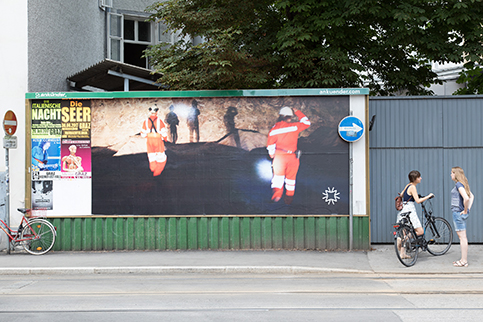
Ruth E Lyons, Billboard at Maiffredygasse 3, as part of WWWW, new commission for Summer 2017, Grazer Kunstverein. Photography by Thomas Raggam.
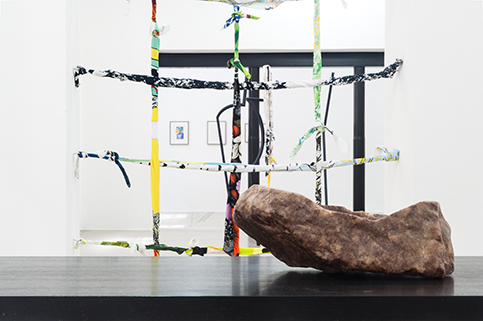
Installation view showing Salarium by Ruth E Lyons, and Reluctant Soft Furnishings by Edward Clydesdale Thomson. On display for Summer 2017, Grazer Kunstverein. Photography by Christine Winkler.
Ruth E Lyons
WWWW: Women’s Wear for Worldly Work, 2017
WWWW stands for Women’s Wear for Worldly Work, and celebrates the spectacular potential of gender parity. The project stems from the artist’s personal experience of working as a female cultural producer in various male-dominated industrial environments ranging from salt mines, construction sites to fabrication workshops and being continually frustrated by the lack of purpose designed work-wear for women working in such scenarios. WWWW is an urgent visual and performance-based response to the marginalization of women that this lack represents as we face rapid and widespread industrialization of world landscapes.
In the evolution of WWWW the research, focus groups, business pitch, marketing strategies and development of test pieces at the Grazer Kunstverein, each become sites for performative gestures that highlight the often unconscious bias built into commonplace situations and environments. In this way WWWW explores how the structure of our clothing and the shape of our landscape are part of vast historical systems that inhibit the feminine. Simultaneously these performative strategies offer an imaginary and spectacular vision of the potential of embraced gender parity through the creation of forms that give space for the female to embody a fully expressive, capable, physical role in the activity of world making. The artist Ruth E Lyons, accompanied by her young baby Maurice Bingo Lyons, were on residence at the Grazer Kunstverein for the Summer of 2017. During her stay, the artist, together with Martin Griesbacher and Sabine Hirzer, held a series of focus groups for participants from Graz-based industry, to develop research towards a new line of clothing. This co-operation with the Institute of Art History of the Karl-Franzens-University of Graz took place within the scope of the research project ‘Fine Feathers Make Fine Birds, or Contemporary Art between Ars and Techne. Concerning the Outstanding Significance of Art Production in Styria for Relational Aesthetics in the International Art Context. A Project for the Exploration of a Desideratum for Contemporary Art Historiography.’
Commissioned in 2017 by the Grazer Kunstverein, and presented with the support of Culture Ireland.

Fiston Mwanza Mujila, performance of Le Fleuve dans le Ventre / Der Fluß im Bauch, as part of Summer 2017, Grazer Kunstverein. Photography by Thomas Raggam.

Fiston Mwanza Mujila, performance of Le Fleuve dans le Ventre / Der Fluß im Bauch, as part of Summer 2017, Grazer Kunstverein. Photography by Thomas Raggam.
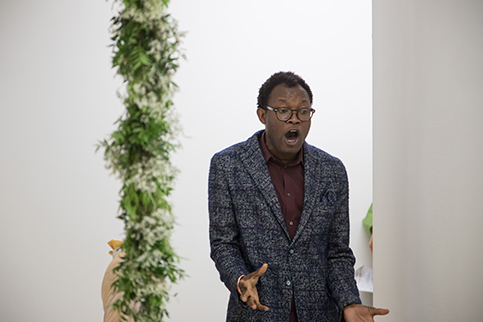
Fiston Mwanza Mujila, performance of Le Fleuve dans le Ventre / Der Fluß im Bauch, as part of Summer 2017, Grazer Kunstverein. Photography by Thomas Raggam.

Fiston Mwanza Mujila, Le Fleuve dans le Ventre / Der Fluß im Bauch, on display for Summer 2017, Grazer Kunstverein. Photography by Thomas Raggam.
Fiston Mwanza Mujila
Le Fleuve dans le Ventre / Der Fluß im Bauch [The River in the Belly]
‘When I was a child, I always believed that the Congo River belonged to me. Father told us daily that the Congo River is ours, that the river is a family flow, a tribute to all the rivers of the world: Zambezi (2574 km), Yangtze (6380 km), Mississippi (3778 km), Yenisei (approx 3487 km), Mackenzie (1903 km), Danube (2857 km), Mekong (4350 km), Rhine (1233 km), Congo (4374 km), Brahmaputra (3100 km), Rio Grande (3034 km) etc.’ – Fiston Mwanza Mujila
The Congo River is a great heaving mass of water, an unstoppable force of nature that arcs through the Democratic Republic of Congo (DRC). The deepest river in the world, it was gifted to a young Fiston Mwanza Mujila by his father when he was a child. Since then it has been a major source of inspiration for his text-based practice, so much so that he dedicated an entire collection of poetry to it. Mwanza Mujila writes poetry, fiction, and works for the stage. ‘Le Fleuve dans le Ventre / Der Fluß im Bauch’ [The River in the Belly] uses text to embody the Congo River, becoming that great ambiguous wave of ferocious laziness, that brings with it life but also carries away the dead. Mwanza Mujila is impregnated with the river, an act not of love but of violence, as he uses his muse to reflect on the turbulent and chaotic years of civil war and dictatorship that have marked the DRC since independence in 1960. The Summer Season at Grazer Kunstverein opened with a performance of an extract of the text, by Fiston Mwanza Mujila.
Le Fleuve dans le Ventre / Der Fluß im Bauch, RANITZPRINT NO. 18, Bilingual edition translated from the French by Ludwig Hartinger, with 8 chalk drawings by Christian Thanhäuser, 144 pages, thread stitching, ISBN-978-3-900986-79-7. Published by Edition Thanhäuser, 2013.

Edward Clydesdale Thomson, detail of In a green shade (Butterfly house), on display for Summer 2017, Grazer Kunstverein. Photography by Thomas Raggam.

Edward Clydesdale Thomson, Installation view showing Reluctant Soft Furnishings and The Distracted Gardener, on display for Summer 2017, Grazer Kunstverein. Photography by Thomas Raggam.
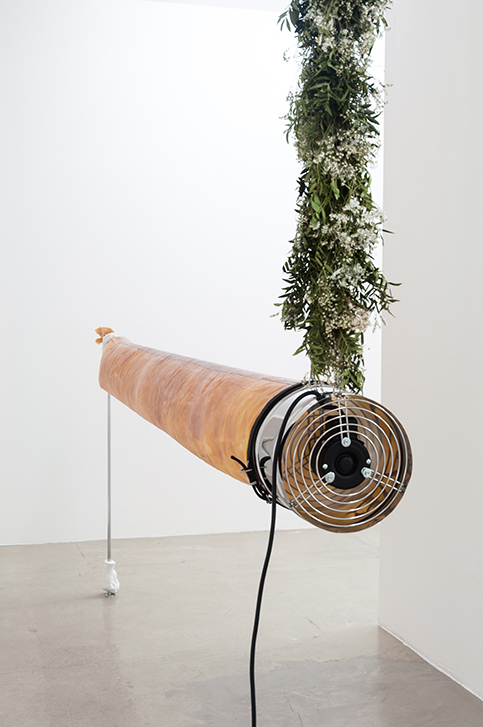
Edward Clydesdale Thomson, Inflatable Paradise, on display for Summer 2017, Grazer Kunstverein. Photography by Christine Winkler.
Edward Clydesdale Thomson
The Coming Garden, 2017
Edward Clydesdale Thomson is plotting out a garden for the Grazer Kunstverein – it will become a real, living environment that will gradually grow, flourish and decay throughout the coming years. The first iteration of this long-term project is presented for the Summer Season of 2017. Tools and ropes, fans and hoses lay the groundwork in a sculptural garden planted around the concrete galleries. This installation combines sculptural works in which abstracted tools bridge a transition between house and garden, from the realm of the domestic and personal, to the symbolic and collective. With this he investigates the notion of landscaping as an activity that has resonance with art making in being able to sculpt and delimit a space of both production, experience and care.
For Ernst Fischer mankind’s conscious control over nature was one of the most important, magical and distinguishing features of the human condition. Responding to this sentiment, the artist complicates and questions our desire to influence the natural world by intensively reflecting on our role as artists within it.
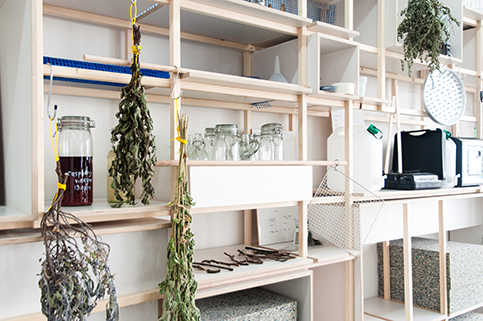
Fiona Hallinan, Fink’s, ongoing commission for Summer 2017, Grazer Kunstverein. Photography by Christine Winkler.
Fiona Hallinan
Fink’s, 2017–2020
Bar designed and built by Studio Magic and Brauchst Collective
Set in the reception area of the gallery, Fink’s is an ongoing, collaborative artwork developed by Fiona Hallinan in conversation with the many producers, makers and growers of Graz and the surrounding area. Fink’s functions as a threshold, a welcoming space for conversations about art and the world, a repository of tastes, recipes and memories, and a holistic space for dreaming and scheming. It operates principally on the basis of meaningful exchange with members of the Grazer Kunstverein.
Established as a ‘library of tastes’, every season, a new powder is created by drying and distilling the essence of what has been collected and cooked during the opening week. The powder is available for every visitor of the Grazer Kunstverein to take away. Throughout Summer, Fink’s is also becoming a functioning library – whereby tools can be borrowed from its growing inventory. This year the focus is on dehydration, an ancient form of preservation that has been used for many centuries as a technique, often just by laying things out flat in the sunshine. The electric dehydrator replicates this process, and is available to borrow for members of the Grazer Kunstverein for set periods of time.
Commissioned in 2017 by the Grazer Kunstverein.
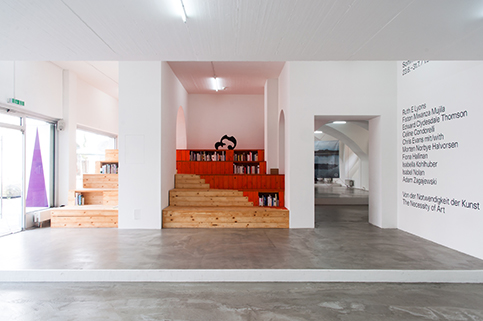
Céline Condorelli, Things That Go Without Saying, on display for Summer 2017, Grazer Kunstverein. Photography by Christine Winkler.
Céline Condorelli
Things That Go Without Saying, 2013–2020
In 2013 Céline Condorelli was commissioned by former director Krist Gruijthuijsen to produce a new work for the Grazer Kunstverein as part of The Members Library. The outcome was Things That Go Without Saying, realised in collaboration with Harry Thaler. The structure operates at a scale between furniture and architecture, and has become truly the heart of the building. It currently houses over 400 books, each of which have been selected for inclusion by our members. The library (of books) will continue to grow, and the structure continues to host or support newly commissioned work by other artists. During our Summer Season the structure hosts a wearable sculpture by Isabella Kohlhuber, available for short term loans to visitors of the Grazer Kunstverein.
Commissioned in 2013 by the Grazer Kunstverein.

Isabella Kohlhuber, untitled (stool) as part of Space for an Agreement, on display for Summer 2017, Grazer Kunstverein. Photography by Thomas Raggam.
Isabella Kohlhuber
Space for an Agreement, 2016
Isabella Kohlhuber’s practice engages with typography as a form of thought process. Her work Space for an Agreement interrupts the conventional readings of an artwork, in both its formal sculptural presence and its potential functionality. This work will accompany us through our year-long programme, exploring the necessity of art in the in-between space of form and function. For Summer, the objects become incorporated into the administrative life of the Grazer Kunstverein, where they live for this season as office and gallery furniture.
Courtesy of the artist and Galleria Doris Ghetta.
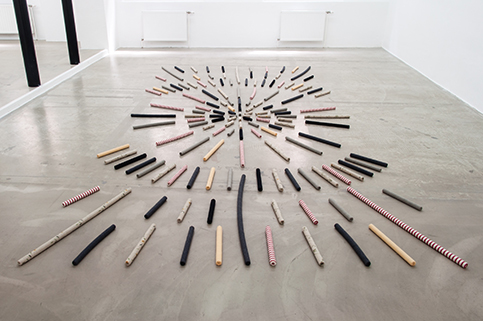
Isabel Nolan, The Provisory Rug, adaptable for past, present and future. (For Marie Lieb), on display for Summer 2017, Grazer Kunstverein. Kindly on loan from Ernst Siegel Collection, Vermont, USA. Photography by Christine Winkler.
Isabel Nolan
The Provisory Rug, adaptable for past, present and future. (For Marie Lieb), 2012
Inspired initially by the unusual actions of a woman in a room in Heidelberg in 1894, Isabel Nolan’s sculptural floor piece takes on many different forms and dedications. This disobliging carpet accompanies us in various configurations throughout our 2017 programme. The first (spring) iteration was Spare Rug for Marie Lieb’s room, Heidelberg Psychiatric Hospital, 1894 (a.k.a. Circumstances shape an emptiness), 2012. For Summer, the 144 bars of upholstered mild steel are reconfigured to compose the work Travel Rug for Philosopher and Theologian Giordano Bruno (b.1548 – d.1600) who hypothesized that the universe is infinite, 2012. Giordano Bruno, an excommunicated Dominican friar burned at the stake for his heresies in 1600, was born in Nola, Italy. An itinerant philosopher, poet, memory expert and cosmological theorist, ‘The Nolan’ held many controversial beliefs including that the universe was infinite, worlds like our own were multiple, and that the devil would be saved. This explosive arrangement of the carpet is dedicated to him, and is presented in the company of three new drawings by the artist.
Courtesy of the Kerlin Gallery and Ernst Siegel Collection, Vermont, USA.

Isabel Nolan, three drawings on paper (2012–2015): Based on my recent observations (no.8); Giordano, 1548–1600; and Giordano Bruno: On the immense and the numberless, on display for Summer 2017, Grazer Kunstverein. Photography by Christine Winkler.
Chris Evans
in collaboration with Morten Norbye Halvorsen
Jingle, 2017–2020
Chris Evans, in collaboration with Morten Norbye Halvorsen, has produced a jingle for the six entrance doors of the Grazer Kunstverein, set to cumulatively proclaim and broadcast the arrival of each visitor. A new jingle is presented at the change of every season. Spring’s jingle was inspired by Austrian band Supermax, and the idea of an ascending or descending Shepard scale. For Summer, Chris and Morten will continue with some bass melodies that are reminiscent of interludes in American sitcoms, with the addition of some deer cries.
Commissioned in 2017 by the Grazer Kunstverein.

Chris Evans with Morten Norbye Halvorsen, exterior view of Jingle (installed throughout the six entrance doors), on display for Summer 2017, Grazer Kunstverein. Photography by Christine Winkler.
Adam Zagajewski
We Know What Art Is, 2013
Adam Zagajewski is a poet, novelist, translator and essayist. He first became well known as one of the leading poets of the Generation of ‘68’ or the Polish New Wave (Nowa fala); today he is one of Poland’s most well known contemporary poets. Now part of our year-long programme, this poem, which exists ephemerally on the tips of tongues, first appeared in English in issue 136 of The Threepenny Review in Winter 2014. For a one-to-one recitation of the poem please ask a member of our staff.
Courtesy of the author Adam Zagajewski and translator Renate Schmidgall

View of Ernst Fischer Library, on display for Summer 2017, Grazer Kunstverein. Photography by Christine Winkler.
Ernst Fischer
The Necessity of Art, 1959
Ernst Fischer(b. 1899, Komotau, Bohemia, d. 1972 Deutschfeistritz, Austria) was a journalist, writer, politician and author of ‘The Necessity of Art’. He studied philosophy in Graz, and was credited as a dramatist during the 1920’s in Vienna. He is cited as asserting the slogan “Art must do nothing, yet can do everything”* In the mid-thirties, having become convinced that only communism could halt the rise of fascism, Fischer went to Moscow from where he embarked on a long and turbulent political career. One of Fischer’s most fascinating aspects is his capacity for self-reflection, as articulated in an essay titled ‘Was that Me?’ featured in An Opposing Man (first published in 1974). Throughout the Summer Season we continue to reflect on Fischer’s important and influential legacy to art and to the contemporary world, with a half-day conference dedicated to exploring his legacy and influence. The conference featured talks by Marina Fischer-Kowalski and Eugen Gross among others, and a book presentation by CLIO: Association for History and Education.
*Rabinbach, Anson G., Passage to Politics: Ernst Fischer as Critic, Writer and Dramatist in the 1920’s, Modern Austrian Literature, Vol. 8, No. 3/4, 1975
|
![]()
![]()